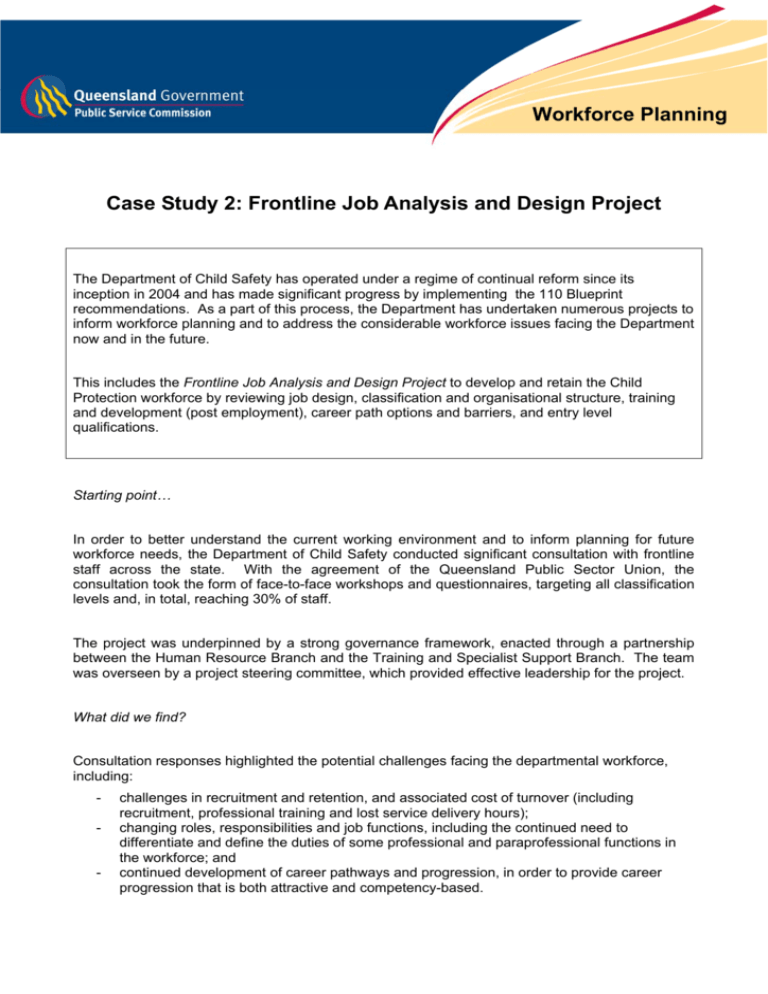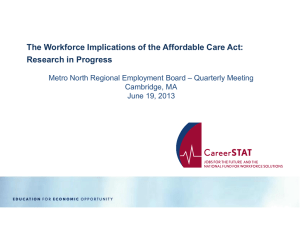Workforce Planning Case Study 2: Frontline Job Analysis and
advertisement

Workforce Planning Case Study 2: Frontline Job Analysis and Design Project The Department of Child Safety has operated under a regime of continual reform since its inception in 2004 and has made significant progress by implementing the 110 Blueprint recommendations. As a part of this process, the Department has undertaken numerous projects to inform workforce planning and to address the considerable workforce issues facing the Department now and in the future. This includes the Frontline Job Analysis and Design Project to develop and retain the Child Protection workforce by reviewing job design, classification and organisational structure, training and development (post employment), career path options and barriers, and entry level qualifications. Starting point… In order to better understand the current working environment and to inform planning for future workforce needs, the Department of Child Safety conducted significant consultation with frontline staff across the state. With the agreement of the Queensland Public Sector Union, the consultation took the form of face-to-face workshops and questionnaires, targeting all classification levels and, in total, reaching 30% of staff. The project was underpinned by a strong governance framework, enacted through a partnership between the Human Resource Branch and the Training and Specialist Support Branch. The team was overseen by a project steering committee, which provided effective leadership for the project. What did we find? Consultation responses highlighted the potential challenges facing the departmental workforce, including: - - challenges in recruitment and retention, and associated cost of turnover (including recruitment, professional training and lost service delivery hours); changing roles, responsibilities and job functions, including the continued need to differentiate and define the duties of some professional and paraprofessional functions in the workforce; and continued development of career pathways and progression, in order to provide career progression that is both attractive and competency-based. What can we do with this information? From the initial phase of the project, a research report was developed. It recommended a number of major structural and job design changes to the Department’s frontline workforce, as well as associated support initiatives including revised training and selection methods. The recommendations from the research report are currently being implemented. So far: • • • • $2.2 million has been included in the current budget to provide better career progression opportunities, work structures and job design for frontline staff, funding which was in large part due to the recommendations of the report. The report’s recommendation of accelerated progression of frontline staff with three years experience to the next classification level has been enacted and the process is well underway. This process has also led to the piloting of a new Principal Child Safety Officer position. Seven of these new positions will be spread across the state and the process for recruitment is underway. Finally, the department has also committed a number of resources to undertake a full review of selection methods not just for Child Safety Officers but all staff in the department. What have we gained? The collection of quantitative and qualitative data from the frontline workforce to inform ways in which the department needs to plan for the future has been a pivotal component of the workforce planning process. This information has led to reforms which will go a long way towards improving retention in the department, both for the current and future workforces. For further information If you would like more information about the project, please contact: Andre Degreef Manager, Strategic Workforce Planning and Recruitment Department of Child Safety 3224 7420 Pat Thorpe Principal Policy Officer Public Service Commission 3224 5514 Department of Child Safety – Frontline Job Analysis and Design Project






